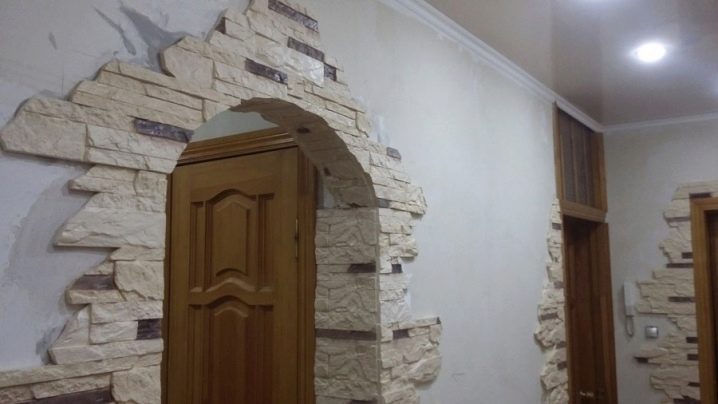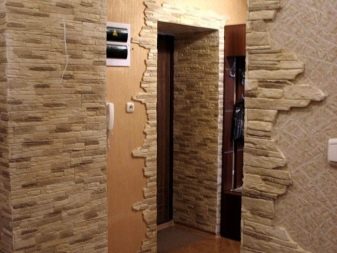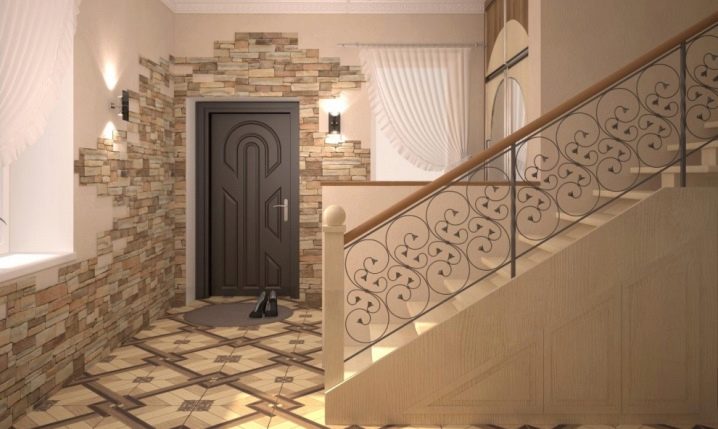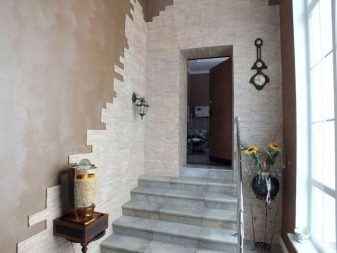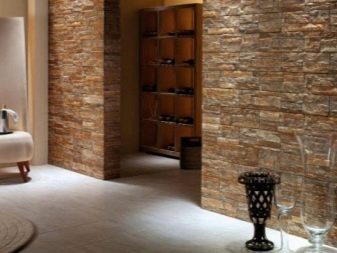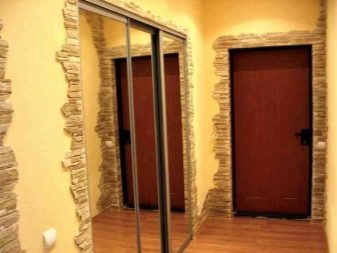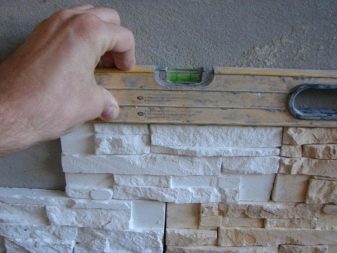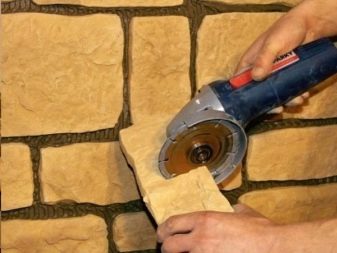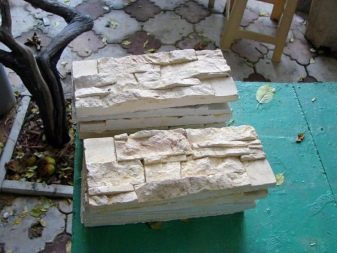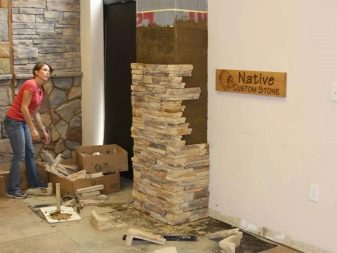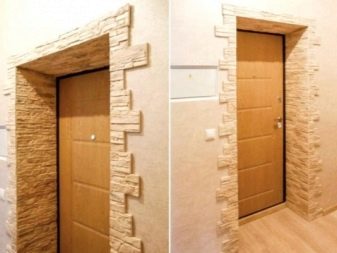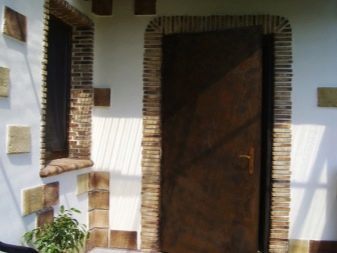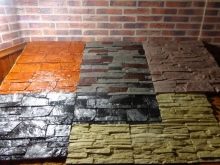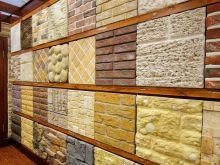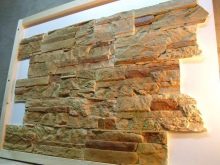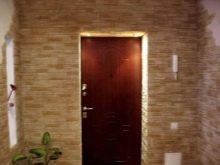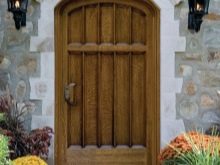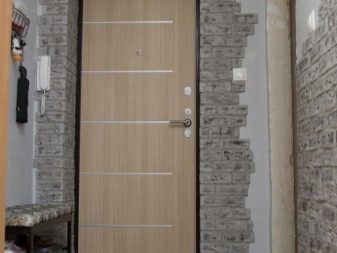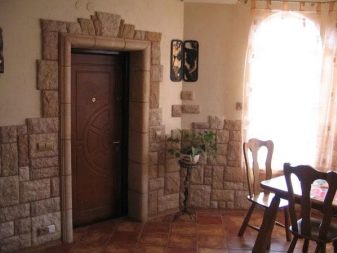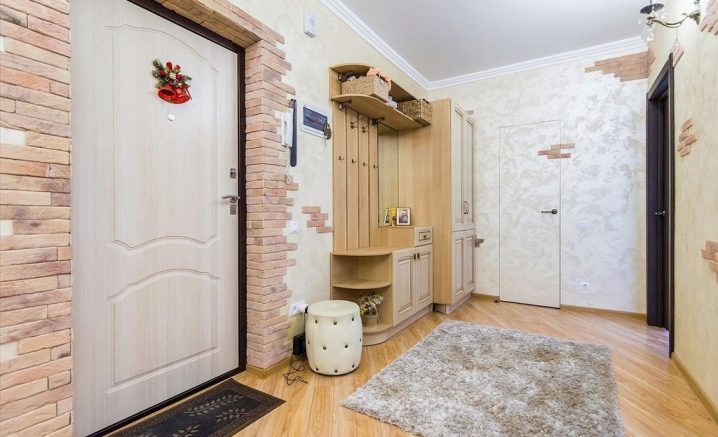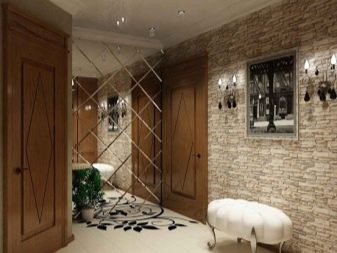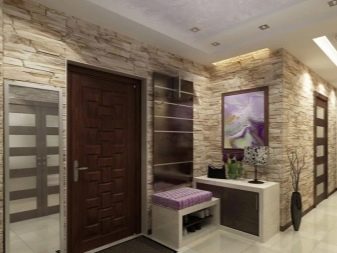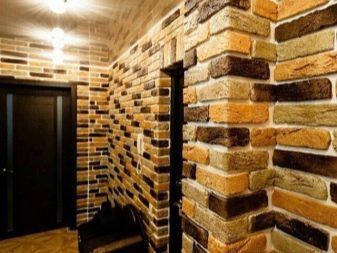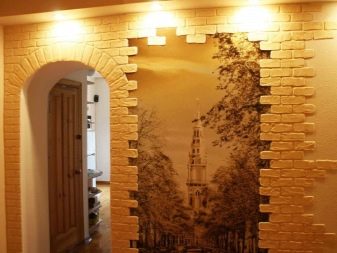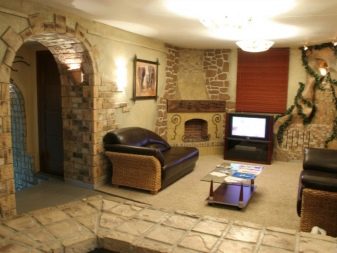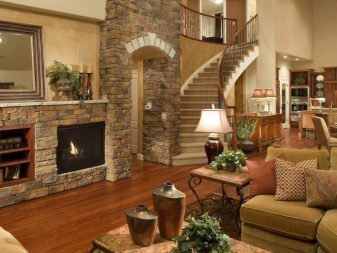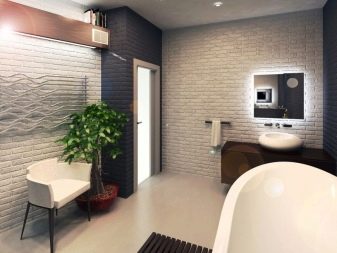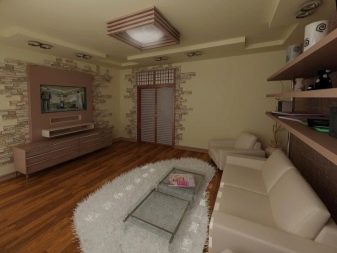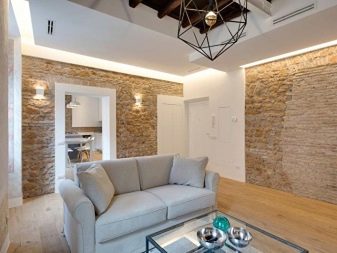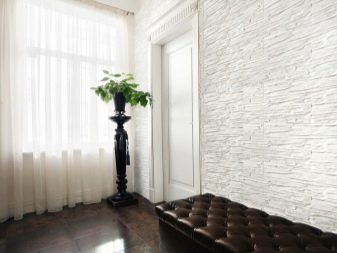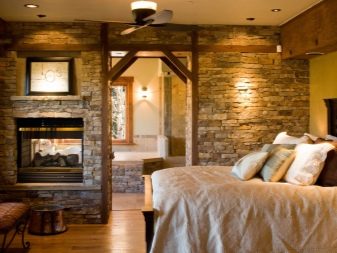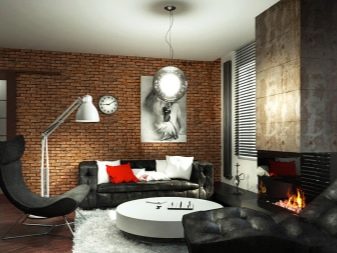Decorating door stone with decorative stone: design ideas

Decorative finishing of a stone is one of the most popular ways of decoration of door jambs. This option is used to decorate doorways, entrance doors. This type of lining creates a warm atmosphere in the house.
Special features
The advantage of artificial stone is that it allows you to imitate rough masonry, but the appearance of the assembled plates looks very natural and neat. It is used to finish the doors in cottages and apartments. A properly installed stone is durable compared to plaster or wood.
Dirt is less noticeable on the plates, and the colors do not fade with time, since the stone panels are additionally protected by impregnation.
The advantages of artificial stone trim are as follows:
- beautiful appearance;
- comfort;
- ease of assembly process;
- various options;
- long service life;
- low surface load compared to natural stone;
- environmentally friendly material.
Kinds
The study of the main types and materials will determine which product is suitable for home decoration. There are three types of artificial stone: brick, rock, cobblestone. The composition of the parts used material concrete and gypsum.
- Concrete stone - It is an ideal choice for people who are looking for a universal facing, used both inside and outside. Concrete is durable, resistant to mechanical damage and weather. Especially valuable material in places of temperature and high humidity.
- Gypsum stone is ideal for people who want to install stone panels in the fastest and least complicated way. Its advantage is light weight and ease of assembly.
Advantages and disadvantages
The use of stone as a cladding indoors - this is one of the most attractive solutions, giving the building its own style. Knowing the advantages and disadvantages of the product, you can make the right choice.
The use of decorative stone in the interior has several advantages.
- Decorative rock attracts attention with its beauty and naturalness. Plates are suitable for decoration of the wall outside and inside the building. The pronounced structure and natural colors will suit any interior. The aesthetic effect is enhanced by the skillful use of lighting - these are shadows on the uneven surface of the stone, which create unforgettable visual effects.
- Complementarity. Stone fits perfectly into a different style of wall cladding. Placing the plates on a small fragment of the surface next to the doors creates an original look. If the design of the door occurs in the corridor, then a smooth transition of the plates to the furniture in the form of an ordinary strip will be a great combination. It is important that the colors of the furniture and decorative stone be in the same tone.
- Fastening of an artificial stone is carried out with the help of liquid nails.
- Gypsum is easily cut with a saw, and the absorbency of the material makes it possible to paint it with any color.
Decorative stone has several drawbacks.
- The stone has a porous structure, it absorbs dust, fungi and water, and it is difficult to clean the plates to a new type.If you use parts to finish the doors on the street of a private house, then over time the material becomes dirty, especially light decorative stones. To prevent such consequences, it is necessary to treat the surface with a water repellent. The composition impregnates the plates and there is a protective film from external environmental influences. The color of the details becomes brighter.
- For the installation of stone does not fit the usual concrete surface. Need to glue on the plastered wall. And also can not be glued to drywall, because the details will tear off the top layer of material.
How to choose?
When choosing a decorative stone, it is important to take care of the internal stylistic orientation of the details that will be combined with the style of the apartment. Before buying an artificial stone should pay attention to the color, size, depth, as well as the smoothness or roughness of the structure.
Experts recommend sticking to general guidelines for choosing.
- Price. Facing stone is a mixture with the addition of dye. Responsible manufacturers use high quality materials. The cost of ingredients can not be very low, which affects the final cost of the product.
- Appearance sample. It has an even coloring on the details. Paint should be evenly distributed throughout the object. Poor-quality color is the output of the dye on the adjacent plates. The front side should be neatly dyed and free from smudges, scuffs and through holes. Holes on the plates have a negative impact - reduce the service life.
- Stone cut. High-quality artificial product has a homogeneous structure. Particle size does not exceed 5 mm, otherwise the probability of splitting the stone. The cut helps determine how it is stained. If the cut color details slightly differs from the surface of the product, it means that the plates are painted to the full depth. During the manufacture of parts, the dye is added to the mass during kneading, which means that small chips and scratches on the surface of the stone will not be visible and will not spoil the appearance of the masonry.
- For decoration of entrance doors in the open air - houses, terraces, balconies, the material must be resistant to frost, dynamic fluctuations in temperature and high humidity. The advantage of this finish is an additional layer of insulation: protection of parts from heat loss in winter and from excessive heating in summer.
- For surfaces subject to high humidity or direct contact with water, you need to use a concrete stone that is resistant to absorption due to its structure.
- Do not choose gypsum material for finishing doorways, doors inside the bathroom or bath.
- With your own hands, you can also trim interior doors, window slopes.
Tip! In the case of existing uneven jambs, you can apply a decorative stone, it will help to hide the defects.
The time of day and the type of light are important because the texture of the stone cladding causes a light and shade effect around. The smaller the surface for finishing, the more cautious it is to choose the structure of the stone in order to avoid overwhelming and optical reduction of the interior.
Designer Tips
Modern interiors of houses have large monochrome surfaces. The goal of designers is to create an impression of the visual expansion of a room or, conversely, reduce zones so that the background of the room is harmonious. Such minimalism is a real problem for the designer, since this style is sensitive to the proportions of the parts used.
Many people are looking for ready-made solutions that will become the main idea and will reveal the best features in the design of the room, both in general and in detail.
The stone perfectly imitates the appearance of bricks, pebbles or naturally crushed fragments of rocks, giving the rooms a unique character.
To decorate the wall near the doors and doorways, the designers put forward a classic stone model - this imitation of ordinary brick. This type of interior gives the proper character. Due to the subtle shading, the three-dimensional effect of the surface is emphasized, which will be noticed by each guest of the house.
If you match the color of the surface of the walls, a smooth transition will occur that will not stand out from the overall color scheme of the room. There will be a balance of the existing style with a new wall decoration. This is an ideal choice for all interiors that are looking for their individuality, have a specific idea for placement in space, but do not have distinctive features. The introduction of bricks ensures the revitalization of the internal layout and will give the place its character.
Designers recommend paying attention to the appearance of the stone, which affects the following characteristics:
- type of lighting used (day and artificial);
- the presence of materials placed on the same or adjacent surface (light or dark background);
- impregnation of the panel, which not only protects the product from external conditions, but also sharpens the color.
Considering the most unique elements of the decorative stone, namely its deep structure, we can expect completely different visual effects. In sunlight, the plates will glitter, with artificial light may be darker.
The best options
Decorative stone collections differ in the method of production, surface texture and color. All of these functions create a specific pattern, which is called a style.
- For home made in minimalism style, decorative stone acts as zoning. Apply for a decor opaque, but saturated colors of details. If the room does not have enough light, you should apply a wall with a glossy surface. Base tones are black and white.
- Classical The style takes smooth and uniform plate shapes. The dominant colors in the interior are beige and cream. Imitation of stone happens under agate, alunite. Such a stone will emphasize expensive furniture, and the muffled warm light will create a cozy atmosphere.
- High tech With contrasting colors and geometric shapes, it will perfectly complement an artificial black stone against a white wall with metal accessories.
- For lovers of eco-style in a green and white color, the decoration of a snow-white stone looks excellent, where it is complemented with live plants in pots.
- Rustic style will emphasize the standard smooth form of brown or muted orange brick color. Such details will be harmoniously combined with furniture.
- Style interior loft It is difficult to imagine without the elements of brickwork. Indeed, without such fragments, the atmosphere of this direction is lost. You need to choose a plaster material of blue, white shades. To update the details after a while, will require painting at will.
Decorative stone attracts attention. It creates an impression and defines the style of the interior more than any other design element.
For detailed instructions and tips on laying decorative stone, see the video below.
